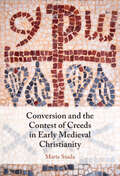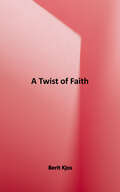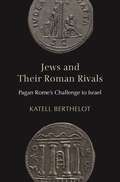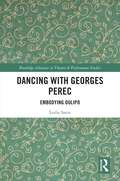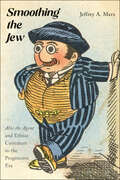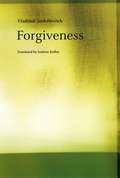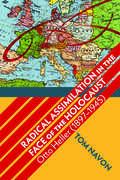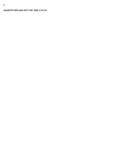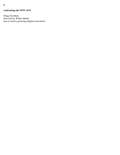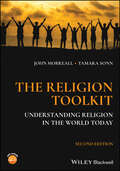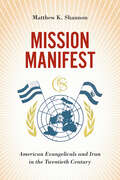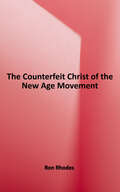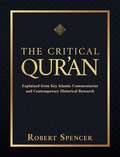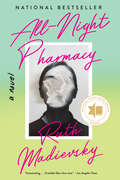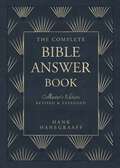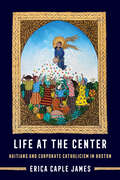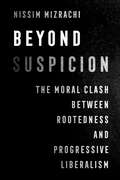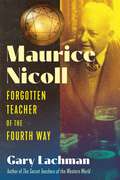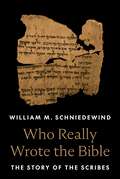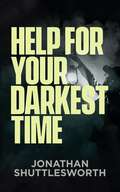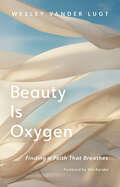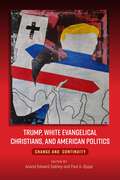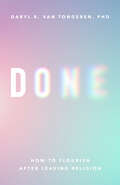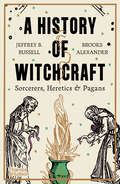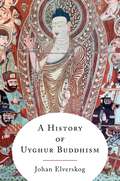- Table View
- List View
Conversion and the Contest of Creeds in Early Medieval Christianity
by null Marta SzadaAs the Roman Empire in the west crumbled over the course of the fifth century, new polities, ruled by 'barbarian' elites, arose in Gaul, Hispania, Italy, and Africa. This political order occurred in tandem with growing fissures within Christianity, as the faithful divided over two doctrines, Nicene and Homoian, that were a legacy of the fourth-century controversy over the nature of the Trinity. In this book, Marta Szada offers a new perspective on early medieval Christianity by exploring how interplays between religious diversity and politics shaped post-Roman Europe. Interrogating the ecclesiastical competition between Nicene and Homoian factions, she provides a nuanced interpretation of religious dissent and the actions of Christians in successor kingdoms as they manifested themselves in politics and social practices. Szada's study reveals the variety of approaches that can be applied to understanding the conflict and coexistence between Nicenes and Homoians, showing how religious divisions shaped early medieval Christian culture.
A Twist of Faith
by Berit KjosBerit Kjos is convinced that millions of women are traveling down cultural freeways to self-made spirituality. Why, she asks, have feminist myths and goddesses replaced biblical faith for many Christians who have embarked on journeys of self-discovery?
Jews and Their Roman Rivals: Pagan Rome's Challenge to Israel
by Katell BerthelotHow encounters with the Roman Empire compelled the Jews of antiquity to rethink their conceptions of Israel and the TorahThroughout their history, Jews have lived under a succession of imperial powers, from Assyria and Babylonia to Persia and the Hellenistic kingdoms. Jews and Their Roman Rivals shows how the Roman Empire posed a unique challenge to Jewish thinkers such as Philo, Josephus, and the Palestinian rabbis, who both resisted and internalized Roman standards and imperial ideology.Katell Berthelot traces how, long before the empire became Christian, Jews came to perceive Israel and Rome as rivals competing for supremacy. Both considered their laws to be the most perfect ever written, and both believed they were a most pious people who had been entrusted with a divine mission to bring order and peace to the world. Berthelot argues that the rabbinic identification of Rome with Esau, Israel's twin brother, reflected this sense of rivalry. She discusses how this challenge transformed ancient Jewish ideas about military power and the use of force, law and jurisdiction, and membership in the people of Israel. Berthelot argues that Jewish thinkers imitated the Romans in some cases and proposed competing models in others.Shedding new light on Jewish thought in antiquity, Jews and Their Roman Rivals reveals how Jewish encounters with pagan Rome gave rise to crucial evolutions in the ways Jews conceptualized the Torah and conversion to Judaism.
Dancing with Georges Perec: Embodying Oulipo (ISSN)
by Leslie SatinThis book explores the relationship of the life and work of the remarkable Parisian-Jewish writer Georges Perec (1936–1983) to dance."Dancing" addresses art-making parallels and their personal and sociocultural contexts, including Perec’s childhood loss of his parents in the Holocaust and its repercussions in the significance of the body, everydayness, space, and attention permeating his work. This book, emerging from the author Leslie Satin’s perspective as a dancer and scholar, links Perec’s concerns with those of dance and demonstrates that Perec’s work has implications for dance and how we think about it. Moreover, it is framed as a performative autobiographical enactment of the author's relationship to Perec, periodically linking their written, danced, and imagined lives.This exploration will be of great interest to dancers, dance scholars, and dance students interested in contemporary experimental dance and contemporary dance.
Smoothing the Jew: "Abie the Agent" and Ethnic Caricature in the Progressive Era
by Jeffrey A. MarxThe turn of the nineteenth century in the United States saw the substantial influx of immigrants and a corresponding increase in anti-immigration and nativist tendencies among longer-settled Americans. Jewish immigrants were often the object of such animosity, being at once the object of admiration and anxiety for their perceived economic and social successes. One result was their frequent depiction in derogatory caricatures on the stage and in print. Smoothing the Jew investigates how Jewish artists of the time attempted to “smooth over” these demeaning portrayals by focusing on the first Jewish comic strip published in English, Harry Hershfield’s Abie the Agent. Jeffrey Marx demonstrates how Hershfield created a Jewish protagonist who in part reassured nativists of the Jews’ ability to assimilate into American society while also encouraging immigrants and their children that, over time, they would be able to adopt American customs without losing their distinctly Jewish identity.
Forgiveness
by Vladimir JankélévitchPhilosopher Vladimir Jankélévitch has only recently begun to receive his due from the English-speaking world, thanks in part to discussions of his thought by Jacques Derrida, Emmanuel Lévinas, and Paul Ricoeur. His international readers have long valued his unique, interdisciplinary approach to philosophy’s greatest questions and his highly readable writing style. Originally published in 1967, Le Pardon, or Forgiveness, is one of Jankélévitch’s most influential works. In it, he characterizes the ultimate ethical act of forgiving as behaving toward the perpetrator as if he or she had never committed the action, rather than merely forgetting or rationalizing it—a controversial notion when considering events as heinous as the Holocaust. Like so many of Jankélévitch’s works, Forgiveness transcends standard treatments of moral problems, not simply generating a treatise on one subject but incorporating discussions of topics such as free will, giving, creativity, and temporality. Translator Andrew Kelley masterfully captures Jankélévitch’s melodic prose and, in a substantive introduction, reviews his life and intellectual contributions. Forgiveness is an essential part of that legacy, and this indispensable English translation provides key tools for understanding one of the great Western philosophers of the twentieth century.
Radical Assimilation in the Face of the Holocaust: Otto Heller (1897–1945) (SUNY series in Contemporary Jewish Thought)
by Tom NavonThis book explores the confrontation of radically assimilated Jews with the violent collapse of their envisioned integration into a cosmopolitan European society, which culminated during the Holocaust. This confrontation is examined through the biography of the German-speaking intellectual and prominent communist theoretician of the Jewish question Otto Heller (1897–1945), focusing on the tension between his Jewish origins and his universalistic political convictions. Radical Assimilation in the Face of the Holocaust traces the development of Hellerʼs position on the Jewish question in three phases: how he grew up to become a typical Central European "non-Jewish Jew" (1897–1931); how he became exceptional in that category by focusing his intellectual work on the Jewish question (1931–1939); and how he reacted to the persecution and murder of European Jewry as a member of the Resistance in occupied France and in Auschwitz (1939–1945). Breaking with the common portrayal of Heller as a self-hating Jew, Tom Navon argues instead that Heller came to lay the foundations for the groundbreaking recognition by communists of worldwide Jewish national solidarity.
Martin Speaks Out On The Cults
by Walter MartinThis book has been used by Christians to equip them to share their faith effectively with cultists and to win those lost souls for the kingdom of God cultists have read this book and it will challenge them to investigate the claims of the true Jesus Christ of the Bible and to abandon the false Christ's of the cults.
Confronting The New Age: How To Resist A Growing Religious Movement
by Walter Martin Doug GroothuisThe first book to tell you how to confront the New Age The threat is growing. So not only do we need to understand the New Age, we need to stem the tide of this growing religious movement. Here's the first book that tells how. You'll find all you need to know for: - Witnessing to New Age adherents - Identifying New Age influences in business seminars - Exposing New Age curriculum in our public schools - Discerning New Age influences in pop psychology, biofeedback therapy, visualization, and New Age music This book takes you a step beyond other books with its practical advice and sound suggestions.
The Religion Toolkit: Understanding Religion in the World Today
by Tamara Sonn John MorreallTHE RELIGION TOOLKIT A comprehensive survey of the study of religion worldwide, from ancient indigenous traditions to today’s religious nationalism. “This is an excellent book that is a good, comprehensive overview of the history of religions and the ways of studying religion within Religious Studies… it really brings religions to life for the reader.” —Gavin Flood, Professor of Hindu Studies and Comparative Religion, Oxford University “The authors provide a clear, first-rate introduction to the study of religions, origins, leading scholars and their theories and beliefs…. This is by far the best introductory volume I am aware of both in terms of substance, clarity, and insights.” — John L. Esposito, Distinguished University Professor, Georgetown University, and Past President of the American Academy of Religion The Religion Toolkit: Understanding Religion in the World Today is a clear and comprehensive introduction to the academic study of religions, providing readers an introduction to the history and theories of Religious Studies, a survey of global religious traditions, and an overview of religion in the public sphere today. Discusses theory and methodology in religion, including the disciplines of anthropology, psychology, philosophy, biblical studies, and theologyDescribes the early development of religion, with overviews of traditions around the world, including Judaism, Christianity, Islam, Baha’i, Hinduism, Zoroastrianism, Jainism, Buddhism, Sikhism, Daoism, Confucianism, and ShintoCovers traditions not commonly addressed in introductory textbooks, such as Santeria, Vodou, Tengrism, and indigenous traditions of the AmericasExamines recent developments and contemporary issues such as secularization, bioethics, and the rise of religious nationalismIncludes access to a companion website with discussion questions, additional material, and helpful primary and secondary sources Providing the knowledge and tools required to explore and understand the nature and roles of religion, The Religion Toolkit: Understanding Religion in the World Today, Second Edition is an excellent introductory textbook for undergraduate and graduate courses in Religious Studies, History of Religion, Religions of the World, and Theory and Method in the Study of Religion, as well as a valuable resource for general readers interested in the role of religion in the world today.
Mission Manifest: American Evangelicals and Iran in the Twentieth Century (The United States in the World)
by Matthew K. ShannonIn Mission Manifest, Matthew Shannon argues that American evangelicals were central to American-Iranian relations during the decades leading up to the 1979 revolution. These Presbyterian missionaries and other Americans with ideals worked with US government officials, nongovernmental organizations, and their Iranian counterparts as cultural and political brokers—the living sinews of a binational relationship during the Second World War and early Cold War. As US global hegemony peaked between the 1940s and the 1960s, the religious authority of the Presbyterian Mission merged with the material power of the American state to infuse US foreign relations with the messianic ideals of Christian evangelicalism. In Tehran, the missions of American evangelicals became manifest in the realms of religion, development programs, international education, and cultural associations. Americans who lived in Iran also returned to the United States to inform the growth of the national security state, higher education, and evangelical culture. The literal and figurative missions of American evangelicals in late Pahlavi Iran had consequences for the binational relationship, the global evangelical movement, and individual Americans and Iranians. Mission Manifest offers a history of living, breathing people who shared personal, professional, and political aims in Iran at the height of American global power.
The Counterfeit Christ of the New Age Movement
by Ron RhodesLike the apostle Paul, Christianity has always stood on Mars Hill between the Epicureans and the Stoics, between atheism and pantheism. Today, they would be called Secular Humanists and New Agers. The first is a materialist, insisting that everything is reducible to matter. The latter are mystics, reducing all to mind or spirit. The former believe there is no God at all, and the latter claim that God is all and that all is God. Both are deadly enemies of Christianity, which confesses that God is the creator of all. At different times in history, one or the other of these enemies of the Christian faith has been the greater threat. Currently, the dominant move in our culture is away from the Epicureans to the Stoics, away from Secular Humanism to the New Age. As Harvey Cox put it in the title of his book, there is a "Turn East." Most Christians are ill-equipped to handle this new trend. We have become accustomed to responding to atheists, who do not believe in God, Christ, the soul, prayer, and life after death. But what about New Agers, who claim to believe in all of these? Of course, beneath their common terminology is an entirely different theology. This is the deceptive nature of the New Age and the need for more careful Christian scrutiny. To date, much of the Christian response to the New Age threat has been popular and even sensational. What has been needed is something more theological and biblical. In this excellent book by Ron Rhodes we have one of the first comprehensive, biblical, and critical responses to the core of New Age error. By centering on the New Age view of Christ, this book at once exposes the heretical nature of New Age teaching as well as highlights the central teaching of Christianity, the unique person and work of Jesus Christ, the God-Man. To be sure, there are more dimensions to New Age teaching than its view of Christ, but there are none more important. Furthermore, by centering on Christology, Rhodes is able to relate many of the other New Age teachings to this essential core doctrine. This book is by far the most comprehensive, biblical, and scholarly critique of any central New Age teaching available today.
The Critical Qur'an: Explained from Key Islamic Commentaries and Contemporary Historical Research
by Robert SpencerA unique resource for understanding the Islamic Holy Book.As Islamic terrorism becomes a distressingly common feature of life in North America and Europe, it has become increasingly important for non-Muslims to be aware of the ideology that animates and motivates jihad violence and Sharia oppression of women and others—an ideology that&’s rooted in Islam&’s holy book, the Qur&’an. English-speaking people, however, have found attempts to understand the Qur&’an and Islam impeded by unclear, densely worded translations and explanatory notes written by Islamic apologists attempting to conceal, rather than reveal, how Islamic jihadis use the texts and teachings of the Qur&’an to justify violence and supremacism, and to make recruits of peaceful Muslims. The Critical Qur&’an, in contrast, makes clear the passages that are used to incite violence. Historian and Islamic scholar Robert Spencer elucidates the Qur&’anic text with extensive references to the principal tafsir, or commentaries, that mainstream Muslims use today to understand the Qur&’an, showing how interpretations that sanction violence are unfortunately not outliers, but central in Islamic theology. The Critical Qur&’an is the Islamic counterpart to numerous critical and skeptical editions of the Bible that have appeared over the last century and more. It is the one edition of Islam&’s book that doesn&’t shy away from elucidating why the holy book of Islam is so frequently quoted and referred to with reverence by people who commit and/or justify acts of violence. It is a basic resource for everyone who wishes to understand the persistent phenomenon of Islamic terrorism, and the peculiar provenance of this most provocative book.
All-Night Pharmacy: A Novel
by Ruth Madievsky*A NATIONAL BESTSELLER*Winner of the California Book AwardWinner of the National Jewish Book Award for Debut FictionFinalist for the Lambda Literary AwardsRachel Kushner meets David Lynch in this fever dream of an LA novel about a young woman who commits a drunken act of violence just before her sister vanishes without a traceOn the night of her high school graduation, a young woman follows her older sister Debbie to Salvation, a Los Angeles bar patronized by energy healers, aspiring actors, and all-around misfits. After the two share a bag of unidentified pills, the evening turns into a haze of sensual and risky interactions—nothing unusual for two sisters bound in an incredibly toxic relationship. Our unnamed narrator has always been under the spell of the alluring and rebellious Debbie and, despite her own hesitations, she has always said yes to nights like these. That is, until Debbie disappears.Falling deeper into the life she cultivated with her sister, our narrator gets a job as an emergency room secretary where she steals pills to sell on the side. Cue Sasha, a Jewish refugee from the former Soviet Union who arrives at the hospital claiming to be a psychic tasked with acting as the narrator&’s spiritual guide. The nature of this relationship evolves and blurs, a kaleidoscope of friendship, sex, mysticism, and ambiguous power dynamics.With prose pulsing like a neon sign, Ruth Madievsky&’s All-Night Pharmacy is an intoxicating portrait of a young woman consumed with unease over how a person should be. As she attempts sobriety and sexual embodiment, she must decide whether to search for her estranged sister, or allow her to remain a relic of the past.
The Complete Bible Answer Book: Collector's Edition: Revised and Expanded (Answer Book Series)
by Hank HanegraaffFind answers to your biggest questions about the Bible and Christian faith.We all have questions about the Bible--whether we have read it or not. Join the more than half a million people who have looked to The Complete Bible Answer Book for answers about the Bible, Christian beliefs, life problems, and what God's Word says about current issues.In this comprehensive guide you will find answers to more than 210 of the top questions people have asked Bible teacher and theologian Hank Hanegraaff, aka the Bible Answer Man, over the last 40 years. Topics include: creation and our existencespiritual giftsthe secret to effective prayersreligions and cultsthe resurrection and afterlifeand many more issues vital to a better understanding of God and living a spiritually nourishing life. Each question is answered in Hanegraaff's scholarly yet approachable style and also includes additional resources for those who want to explore the topics further. The Complete Bible Answer Bookis your go-to resource to get your burning questions answered and enrich your spiritual life.
Life at the Center: Haitians and Corporate Catholicism in Boston (Atelier: Ethnographic Inquiry in the Twenty-First Century #15)
by Erica Caple JamesA free ebook version of this title is available through Luminos, University of California Press's Open Access publishing program. Visit www.luminosoa.org to learn more. In Life at the Center, Erica Caple James traces how faith-based and secular institutions in Boston have helped Haitian refugees and immigrants attain economic independence, health, security, and citizenship in the United States. Using the concept of "corporate Catholicism," James documents several paradoxes of assistance arising among the Catholic Church, Catholic Charities, and the Haitian Multi-Service Center: how social assistance produces and reproduces structural inequalities between providers and recipients; how these inequities may deepen aid recipients’ dependence and lead to resistance to organized benevolence; how institutional financial deficits harmed clients and providers; and how the same modes of charity or philanthropy that previously caused harm can be redeployed to repair damage and rebuild "charitable brands." The culmination of more than a decade of advocacy and research on behalf of the Haitians in Boston, this groundbreaking work exposes how Catholic corporations have strengthened—but also eroded—Haitians’ civic power.
Beyond Suspicion: The Moral Clash between Rootedness and Progressive Liberalism (University of California Series in Jewish History and Cultures #4)
by Nissim MizrachiA free ebook version of this title is available through Luminos, University of California Press’s Open Access publishing program. Visit www.luminosoa.org to learn more. For more than four decades, socially disadvantaged Israeli Mizrahim—descendants of Jews from Middle Eastern and North African communities—have continuously supported right-wing political parties. Scholars, left-wing politicians, and activists tend to view Mizrahim as reacting against their structural exclusion, or more crudely as acting against their own interests, but Nissim Mizrachi locates the source of their so-called paradoxical behavior within the limitations of the liberal grammar by which their outlook and behavior are read. In Beyond Suspicion, Mizrachi turns the direction of inquiry back on itself, contrasting liberal grammar—which values autonomy, equality, and universal reason and morality as the only authentic human choice—with the grammar of rootedness, in which the self is experienced through a web of relational commitments, temporal ties, and codes of collective identity. Recognizing rootedness as a fundamental need and desire for belonging is necessary to understand both scholarly and political rifts in Israel and throughout the world.
Maurice Nicoll: Forgotten Teacher of the Fourth Way
by Gary Lachman• Traces the life of Maurice Nicoll, who left a successful career as a psychiatrist in 1922 to study with G.I. Gurdjieff and P.D. Ouspensky• Explores newly uncovered diaries from Nicoll, revealing his mystical sex practices, his shadow self, and new understandings of his unorthodox teachings• Examines the influence of psychiatrist Carl Jung and Swedish scientist and philosopher Emanuel Swedenborg on Nicoll&’s workIn 1922, Maurice Nicoll (1884-1953) abandoned his successful London psychiatry practice and his direct studies with Carl Jung to move his family just outside of Paris to the Institute for the Harmonious Development of Man, a center recently opened by philosopher, mystic, and spiritual guru G. I. Gurdjieff, the founder of the esoteric system that became known as the &“Fourth Way.&” Nicoll went on to become one of the most passionate teachers of the Fourth Way, committing the final three decades of his life to teaching &“The Work&” in his own unorthodox style.In this revealing biography, Gary Lachman draws on recently uncovered diaries to explore the unusual, syncretic approach Nicoll brought to his teaching of the Fourth Way. He shows how Nicoll is unique in having Jung, Gurdjieff, and Ouspensky as teachers and to have known each of these important figures in esoteric history personally, yet—as Lachman reveals—Nicoll was not a blind devotee by any stretch. Lachman shows how Nicoll incorporated elements of Jungian psychology and Emanuel Swedenborg-inspired mysticism into his exploration and teaching of both Gurdjieff&’s and Ouspensky&’s ideas, as well as into his own best-known work, Psychological Commentaries on the Teaching of Gurdjieff and Ouspensky.Lachman reveals the unorthodox side of Nicoll in fuller detail than ever before through excerpts from recently shared diaries, in which Nicoll included detailed accounts of his own solitary &“self-sex&” erotic experimentations to reach visionary states, along with recordings of his dreams and other personal and mystical reflections. The social details of Nicoll&’s life are also examined, including vivid portraits of the occult scene in the early-to-mid-twentieth century and the communal living situations in which Nicoll sometimes resided. Drawing on his familiarity with hermetic practices and his own experiences with &“The Work,&” Lachman comprehensively explores the significance of Nicoll and the novelty of his thought, offering a profound, needed, and sympathetic but critical study of this man so instrumental to the development and legacy of the Fourth Way.
Who Really Wrote the Bible: The Story of the Scribes
by William M. SchniedewindA groundbreaking new account of the writing of the Hebrew BibleWho wrote the Bible? Its books have no bylines. Tradition long identified Moses as the author of the Pentateuch, with Ezra as editor. Ancient readers also suggested that David wrote the psalms and Solomon wrote Proverbs and Qohelet. Although the Hebrew Bible rarely speaks of its authors, people have been fascinated by the question of its authorship since ancient times. In Who Really Wrote the Bible, William Schniedewind offers a bold new answer: the Bible was not written by a single author, or by a series of single authors, but by communities of scribes. The Bible does not name its authors because authorship itself was an idea enshrined in a later era by the ancient Greeks. In the pre-Hellenistic world of ancient Near Eastern literature, books were produced, preserved, and passed on by scribal communities.Schniedewind draws on ancient inscriptions, archaeology, and anthropology, as well as a close reading of the biblical text itself, to trace the communal origin of biblical literature. Scribes were educated through apprenticeship rather than in schools. The prophet Isaiah, for example, has his &“disciples&”; Elisha has his &“apprentice.&” This mode of learning emphasized the need to pass along the traditions of a community of practice rather than to individuate and invent. Schniedewind shows that it is anachronistic to impose our ideas about individual authorship and authors on the writing of the Bible. Ancient Israelites didn&’t live in books, he writes, but along dusty highways and byways. Who Really Wrote the Bible describes how scribes and their apprentices actually worked in ancient Jerusalem and Judah.
Help for Your Darkest Time
by Jonathan ShuttlesworthA Tool of Deliverance for Every Man and Woman Facing Their Darkest TimeWhether facing financial ruin, battling illness, or grappling with loss, this book will restore hope and empower readers with faith to come out of the pit of despair.Pastor, teacher, and evangelist Jonathan Shuttlesworth doesn’t shy away from the realities of pain and suffering. Instead, drawing from his own struggles, he confronts them head-on, offering actionable insights and empowering faith as tools for overcoming life’s harshest realities.Shuttlesworth distills practical biblical wisdom into six decisive lessons. These aren’t clichés or platitudes, but hard-earned truths that will guide you out of the darkness. With each chapter, you’ll be more equipped to take dominion over your trials with a renewed sense of boldness and purpose.Whether you’re a minister seeking to touch the hearts of your congregation or someone struggling to find a ray of hope in a difficult time, this book is a testament to the power of godly wisdom and the truth of His Word.Shuttlesworth’s message is clear: Your story isn’t over, it’s just beginning.About the Author:Jonathan Shuttlesworth is an evangelist and founder of Revival Today, a global ministry dedicated to reaching lost and hurting people with the Gospel of Jesus Christ. He is also the pastor of Revival Today Church, a Holy Spirit-filled, Bible-believing church that blesses families and the nation.
Beauty Is Oxygen: Finding a Faith That Breathes
by Wesley Vander LugtBeauty is oxygen because it comes from the lungs of God. Isolating individualism, rank injustice, and everyday monotony threaten to suffocate our souls. But Wesley Vander Lugt shows how beauty can breathe life back into us. Written in a graceful cadence that invites readers to turn these pages slowly, Beauty Is Oxygen weaves together theological reflection, poetry, cultural criticism, and Scripture. Throughout, Vander Lugt shows how beauty can break us out of self-centered malaise, promote healing and hope for our broken world, and reenchant our lives. Beauty is about more than positive feelings or pleasing aesthetics. Beauty is as essential to our souls as oxygen is to our bodies. As readers encounter these traces of divine glory in Vander Lugt&’s finely crafted meditations, they will find how Christ will &“make all things new.&”
Trump, White Evangelical Christians, and American Politics: Change and Continuity
by Anand Edward Sokhey and Paul A. DjupeIn Trump, White Evangelical Christians, and American Politics, political scientists Anand Edward Sokhey and Paul A. Djupe bring together a wide range of scholars and writers to examine the relationship between former President Donald Trump and white American evangelical Christians. They argue that, while this relationship—which saw evangelicals supporting a famously unfaithful, materialistic, and irreligious candidate despite self-defining in opposition to these characteristics—prompted many to wonder if Trump himself transformed American evangelical religion in politics, this alliance reflected both change and the outcome of dynamics that were in place or building for decades.Contributors contextualize the Trump presidency within the story of religious demographic change, the growth of politicized religion, nationalistic religious expression, and the ways religion and politics in the United States are enmeshed in the politics of race. These investigations find that the idea of religious “transformation” is not accurate. Instead, the years 2015 to 2022 saw mainly minor changes to the ways religion appeared in public life—but these changes ultimately complemented and advanced an existing white evangelical strategy to increase political and social power as they became a demographic minority in the United States. Taken together, this collection reveals new insights for readers seeking to understand the religious dimensions of Trump’s rise, the reasons evangelicals become political activists, and the multifaceted alliances between secular politicians and conservative religious subcultures.Contributors: Abraham Barranca, Ruth Braunstein, Ryan P. Burge, David E. Campbell, Jeremiah J. Castle, Paul A. Djupe, John C. Green, Sarah Heise, Geoffrey C. Layman, Andrew R. Lewis, Gerardo Martí, Eric L. McDaniel, Napp Nazworth, Shayla F. Olson, Enrique Quezada-Llanes, Kaylynn Sims, Anand Edward Sokhey, Hilde Løvdal Stephens, Kyla K. Stepp, Allan Tellis.
Done: How to Flourish After Leaving Religion (APA LifeTools Series)
by Daryl R. Van TongerenThis book draws from cutting-edge psychological research to provide advice for people who are undergoing religious change. Americans today are leaving religion in record numbers. For many, the faith, practices, and institutions that once provided comfort and guidance no longer fit their beliefs and values. This shift often comes with a price, however. While turning away from religion can bring about freedom, awe, and wonder, it can also engender a profound loss of meaning, purpose, community, and identity. It can threaten our relationships with friends and family. And it can pose a significant challenge to the mental health of even the most resilient among us. How can people who are no longer served by traditional religion find new meaning and purpose? How can they process the grief that often accompanies religious or spiritual change? And how can they address challenging interpersonal relationships with people who do not support or understand their religious change? In this book, psychologist Daryl Van Tongeren draws from psychological theories and research to examine the emotional and social processes involved with religious change and offers science-based guidance for building a new life—with or without religion. If you are rethinking your religious beliefs, have experienced religious loss or struggle, or have undergone a significant religious change, you are not alone. By understanding how people before us have left or transformed their religion, we can discover new ways of finding peace, experiencing meaning, and, if desired, engaging with the transcendent. Let their wisdom—and this book—be your guide.
A History of Witchcraft (Third): Sorcerers, Heretics And Pagans
by Jeffrey B. Russell Brooks AlexanderAn authoritative and concise history of witchcraft from the ancient world up to the present day. Witchcraft has always been a fluid and intriguing belief system that has enchanted and sometimes terrified humanity. Now in its third edition, A History of Witchcraft has established itself as the authoritative history of witchery and the occult. Beginning with magic in the ancient world, Jeffrey B. Russell explores the definition of witchcraft in its many diverse forms, from the worship of the Greek goddess of magic, Hecate, and the witch crazes of the fifteenth and sixteenth centuries to the development of modern witchcraft by Aleister Crowley and Gerald Gardner in the early twentieth century. Brooks Alexander analyzes the development of witchcraft and neo-paganism in the present day, charting the dissemination of modern witchcraft through media and the tensions that arise when a secretive cult becomes an open and recognized religion. This updated edition features a new chapter exploring the challenges that witchcraft has faced in the past decade, including the rise of social media platforms such as Instagram and TikTok, the COVID-19 pandemic, and new neo-pagan groups.
A History of Uyghur Buddhism
by Johan ElverskogToday, most Uyghurs are Muslims. For centuries, however, Uyghurs were Buddhists. By around 1000 CE, they, like many of their neighbors, had decisively turned toward the Dharma, and a golden age of Uyghur Buddhism flourished under the Mongol empire. Dwelling along the Silk Road in what is now northwestern China, they stood at the center of Buddhist Eurasia, linking far-flung regions and traditions. But as Muslim power grew, Uyghur Buddhists converted to Islam, rewriting their past and erasing their Buddhist history.This book presents the first comprehensive history of Buddhism among the Uyghurs from the ninth to the seventeenth century. Johan Elverskog traces how the Uyghurs forged their distinctive tradition, considering a variety of social, political, cultural, and religious contexts. He argues that the religious history of the Uyghurs challenges conventional narratives of the meeting of Buddhism and Islam, showing that conversion took place gradually and was driven by factors such as geopolitics, climate change, and technological innovation. Elverskog also provides a nuanced understanding of lived Buddhism, focusing on ritual practices and materiality as well as the religion’s entanglements with economics, politics, and violence. A groundbreaking history of Uyghur Buddhism, this book makes a compelling case for the importance of the Uyghurs in shaping the course of both Buddhist and Asian history.
